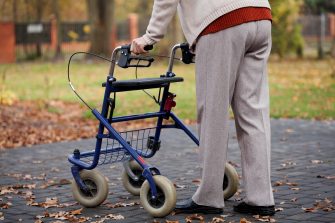Chiropractic Care May Help Reduce Falls Risk for Older Adults
 Falls are a major source of concern for older adults and caregivers. The statistics can be daunting. Did you know:
Falls are a major source of concern for older adults and caregivers. The statistics can be daunting. Did you know:
- More than 80% of injury-related hospitals admissions for people over 65 are a result of a fall.
- Falls are the leading cause of injury-related deaths in older adults.
- Each year, an estimated 30-40% of community-dwelling older adults will have at least 1 fall.
- The rate of falls rises quickly with age (especially over 80) or the presence of lower limb weakness, gait deficits, balance deficits or a history of falling.
Many of the risk factors are a result of the general deterioration that comes from aging. For a specific incident, most falls have multiple contributing factors and cannot be attributed to a single specific cause.
Few studies have explored how chiropractic can influence falls risk. However, there is basic science evidence that indicates chiropractic care may “influence sensory and motor systems that potentially have an impact on some of the neuromuscular risk factors associated with falling.”
Researchers in New Zealand completed a study of 60 community-dwelling adults over 65 years of age to determine what impact 12 weeks of regular chiropractic care would have on the sensorimotor functions commonly linked with fall risk.
Participants were divided into 2 groups: a control group and a chiropractic group. Participant’s sensorimotor function and quality of life were evaluated for the study purposes. Assessments were made when the study initially began, at 4 weeks and at the 12 week conclusion.
The chiropractic group received care from one of 12 local chiropractors. The specific type of care each participant received was determined by the individual chiropractor based on the medical history and exam findings. The control group continued their regular health care routines or any other treatment they had need of during the study time frame.
At the conclusion of the study, the chiropractic group had improved significantly as compared to the control group in multiple sensorimotor tasks as well as the physical component of health-related quality of life.
Differences in the 4 and 12 week assessments revealed a substantial degree of improvement between those evaluations. This may indicate that longer-term care is needed to have a significant effect on some functions.
With an improvement in multiple sensorimotor functions, it is possible that the participants would subsequently have a lower falls risk. How much of an effect as well as exactly how chiropractic impacts these factors is not fully understood.
Because this is an area that has not been studied at length, more research is needed to corroborate these results as well as to determine if these sensorimotor improvements translate into an actual lower occurrence of falls, and to gather longer term data.
SOURCE: Journal of Manipulative and Physiological Therapeutics, Vol. 39, Number 4; “Effectiveness of Chiropractic Care to Improve Sensorimotor Function Associated With Falls Risk in Older People: A Randomized Controlled Trial”. http://www.jmptonline.org/article/S0161-4754(16)00050-6/fulltext